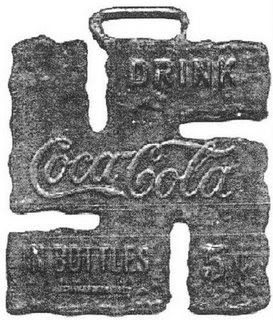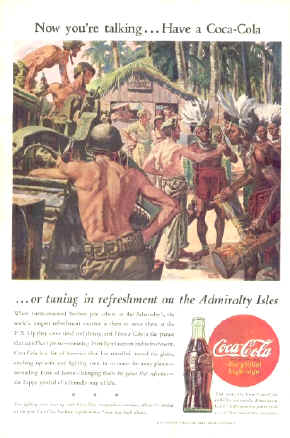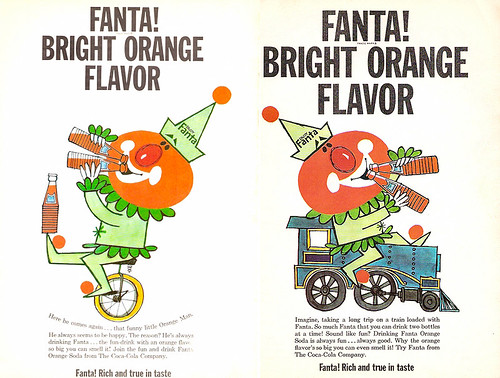(noon. – promoted by ek hornbeck)

Coca Cola’s adroit, questionable practices during the Second World War are legendary. The company managed to play both sides of the European front against each other with breathtaking chutzpah, opportunism, and outright greed.
I stumbled upon this facet of history (or to be more accurate it whopped me over the head with a 2×4) as I wandered an area on Long Island steeped in history, looking for my bottles n’ cans. I was going to get more than I bargained for today.
There’s a building in Garden City – now boarded up and abandoned – just past the Roosevelt Field shopping mall on Old Country Road that used to host a data center for a gigantic hospitality industry “octopus” company called Cendant. Cendant had purchased the Avis rental car agency headquarters and made it their own, so most locals still knew it as the Avis building.
I made waves at Cendant during my first few weeks at Sun Microsystems by solving a three-month-old “severity 1” NetBackup tech support escalation in fifteen minutes. As a result there were those within the company who respected my skills, and for a period of time they became one of my regular clients, until they rolled up the sidewalks and moved their headquarters to New Jersey.
It didn’t hurt that an old college friend worked there, albiet in a completely different department. She was the one who explained to me that the building had been a munitions factory in World War II, and that was why the walls were three feet thick in places, and why it’s hallways were laid out in a maze that otherwise would have made no sense.
Several years later – oh, the rich irony – I stumbled upon the disused railroad tracks that obviously had led between the factory and the Roosevelt Field airfield.
It was rather bewildering. The dusty bottle I’d pulled out of the ground said “Sparkling New Orange Soda” in stylized applique paint that indicated that it would date anywhere from the late 1930s to the early 1960s. OK, fine, there were lots of weird little fly-by-night soda brands that came out back in the day, but on the back of this one it said “Coca Cola Bottling Company”.
I was boggled. WTF?!? This was obviously a Fanta bottle. Come on now, everybody knows that Coca Cola’s version of orange soda is Fanta. Right?
But for whatever reason, it wasn’t being CALLED Fanta. Why?
I found out why.
When I want to find out more about an antique bottle I have found, I search the Internet, or I cruise the Antique Bottles Forum. This is the Internet home of the “diggers” – people like me who have an affinity for finding antique glass in the soil. An elder statesman and respected community authority there, Digger O’Dell, had the first and most in depth answer to my question.
Digger’s explanation clearly goes where the memory hole types have willfully followed and creatively censored for the rest of us. His well-informed explanation hangs together as many of the propagandist versions do not. Digger pulls no punches:
In 1943 alone he (Max Keith, the CEO of Coca Cola GmBH under the Third Reich) sold 3 million cases of Fanta in the Nazi empire.
Mark Prendergrast: “In March of 1938, as Hitler’s troops stormed across the Austrian border in the Anschluss, Max Keith convened the ninth annual concessionaire convention, with 1,500 people in attendance.
Behind the main table, a huge banner proclaimed in German, “Coca-Cola is the world-famous trademark for the unique product of Coca-Cola GmbH” Directly below, three gigantic swastikas stood out, black on red.
At the main table, Max Keith sat surrounded by his deputies, another swastika draped in front of him…The meeting closed with a “ceremonial pledge to Coca-Cola and a ringing three-fold “Seig Heil” to Hitler.”
At another convention Mark Prendergrast notes “Then Keith ordered a mass Sieg-Heil for Hitler’s recent fiftieth birthday, to commemorate our deepest admiration and gratitude for our Fuhrer who has led our nation into a brilliant higher sphere.”
While this was going on in Germany, soon to be cut off from American trade by the existing hostilities, Coca Cola’s American division (is that a good word? Division? Does it sound as military as perhaps it should?) would take advantage of (possibly deliberately engineered?) poor water quality to push Coca Cola on deployed American troops and their allies.

In 1939 Coca Cola only had 5 overseas bottling plants. By 1945, they had 64. What made it so popular? Because the water was disgusting. The army kept it clean by adding chlorine-so the water tasted like your local swimming pool, or worse.
Eisenhower’s insight into the workings of the “military/industrial complex”, which he warned against during his 1961 farewell address, may well have been based on his interactions with the Coca Cola company:
On the 29th June 1943 General Dwight D Eisenhower ordered three million bottles of Coca Cola to be sent to the allies in North Africa.
Plant and machinery for down town bottling plants were also sent so another three million bottles could be sent to the troops every six months.
By the end of the hostilities five billion bottles or cans of Coca Cola had been drunk.
Coca Cola had not only lifted the spirits of the US Armed Forces, it had also introduced itself to new markets. When the war ended the bottling plants and a little bit of America stayed too.
THE PEACE EFFORT
When Eisenhower became President of the USA in 1953, he remembered Coca Cola’s response to his call. He rewarded the company with a contract to supply all White House banquets.
Indeed, what they were doing with American troops during World War II strongly resembles how the British military ensured that every sailor in their Navy had a daily tot of “grog”.
But enough of how Coca Cola used the American miltary. Back to Germany: the CEO of Germany’s Coca Cola plant had died in a car accident shortly before the war began, leaving Max Keith in charge. Various accounts of what he did veer wildly from “he was a loyal Coca Cola upper manager who never joined the Nazi party, didn’t work only for himself and saved lots of people’s jobs” to “he was a Nazi collaborator who engaged slave labor, purchased advertising with Nazi media outlets, and fully supported the Third Reich.”
The truth is somewhere in the middle, and this particular page seems to have a full and solid grasp of that middle. Coca Cola was never out for Nazi Germany, any more than it was for America. COCA COLA WAS STRICTLY AND 100% OUT FOR COCA COLA:
It seems as if the only principle that the Coca-Cola GmbH never betrayed in its history of wheeling and dealing under the Nazis was the product itself. The company fought the Nazi-bureaucracy tooth and nail to keep Coca-Cola unchanged after the Ministry of Economics in 1939 passed out rules demanding that bottles conform to a metric standard based on decimals. Since the Coke bottle contained 180 cubic centimeters instead of 200, the Nazis promptly halted the production of new bottles, showing little understanding for the argument that the production of different-sized bottles would constitute an unacceptable drain on Germany’s scarce glass resources.
Not surprisingly, the company found an ingenious and unscrupulous solution. With the help of Reinhard Spitzy, a well-connected former high official in the German Foreign Office, Coca-Cola manouvred to take advantage of the situation in the recently annexed Sudetenland, where German laws, including the packaging regulations, did not fully apply yet. Spitzy recounts that when he asked the Gauleiter (District Leader) how the local glas industry was coping with the international embargo imposed on all German products after the annexation of Czechoslovakia, he received the answer: “My dear Party Comrade Spitzy, the situation of the glass industry is absolutely shitty, the machines run only a few hours a day.” When Spitzy told him how unfortunate this was given that “the international company Coca-Cola urgently needs millions and millions of new bottles,” the Gauleiter reacted predictably by engineering an import exemption for Coca-Cola bottles manufactured in the Sudetenland.
While this exemption could be regarded as the result of a successful act of opposition against the Nazi bureaucracy, one should not exaggerate the heroism in Coke’s stand: by helping the Sudetendeutsche industries back on its feet, the Coca-Cola GmbH supported the Nazi-government in circumventing an international embargo designed to cripple its rule.
Coca Cola had been marketed very successfully in Germany and the rest of Europe throughout the 20s and 30s, but it was always depicted as an American drink.
All accounts agree that what Coca Cola GmBH, cut off from communication and trade with it’s parent organization did as supplies imported from America dwindled and eventually ran out was to invent the drink known as Fanta. The German CEO, Max Keith, is usually given credit, but the person who actually invented the formula for Fanta was a German chemist named Schetelig in 1940.
Due to hostilities, the German Coca Cola plant could not obtain syrup to make the drink from the American side. Minimal communications were possible between the German and Amarican branches of the company through the Swiss plant. Left more or less completely on his own (or at least that is what we are told), Max Keith came up with a plan to keep the German plant operational that would use ingredients only available in Germany. This turned out to be Fanta. Even the name was coined by a German:
Fanta came by its name thanks to Keith’s instructions to employees during the contest to christen the beverage – he told them to let their Fantasie [Geman for fantasy] run wild. Upon hearing that, veteran salesman Joe Knipp immediately blurted out Fanta.
So while Coca Cola was being aggressively peddled as the drink of the Americans, Fanta became the drink of those living under the auspices of the Third Reich.

As the war progressed and eventually ended, what happened next is a bit murky. No source seems to be available that explains the arrival on US shores of “Sparkling New Orange Soda” as bottled by the Coca Cola Company. Not even Digger O’Dell, antique bottle guru, is able to provide information on when this mysterious drink was first – or last – offered for sale within the United States.
The only hint as to when they might have actually started to refer to this stuff as “Fanta” on this side of the pond comes from an obscure mention in the NY Times that they had engaged an advertising agency on September 21st, 1960 to market their “new acquisition”, Fanta. The same year, Coca Cola acquired it’s first non-softdrink company, Minute Maid, which as everyone knows revolves around the use of orange juice. Coincidence? Oh, please!
Here’s the canned version of what I found:

I found the “Sparkling New Orange Soda” bottle by a set of railroad tracks that had been ignored for decades after World War II. But during World War II, over 100,000 people worked at the airfield alone. This was the heyday of Grumman and Sperry. Long Island was THE most strategically important staging area for our efforts to support our European Allies. As America joined the war effort, Roosevelt Airfield became one of the busiest hotbeds of military activity this country has ever seen. Thousands of troops shipped out to Europe from here by air. The interestingly timed 2001 movie “Pearl Harbor” depicts what it was like.
The area where I found the bottle got it’s heaviest use DURING the war – NOT afterward.
Coca Cola played both ends against the middle. WHILE they were selling Fanta in Nazi Germany, they were selling this rebranded variation to the troops living here who were FIGHTING them.

While selling this innocuously branded version of Fanta throughout America, they waited for the German variety to fade from the general American mindset. Since there’s no information available on exactly when they started selling “Sparkling New Orange Soda” in the US; the only question is how long, exactly, did they wait? 15 years or 20? During the war or afterward? No one seems to know.
Then “introduced” their new “acquisition” with a huge marketing blitz in the United States – a marketing blitz NOT for “Sparkling New Orange Soda”, but FANTA.
Want information about when and where they started selling “Sparkling New Orange Soda”? Well yeah, and good luck with that. There might be someone around who is still alive that you can ask if they remember when they first saw it. Information on the Internet about this drink? Nothing. Bupkus. Crickets.
Despite the information blackout on this variation of the product, the truth is crystal clear. The soda being marketed as “Sparkling New Orange Soda” in the United States WAS the same Fanta that was invented in Nazi Germany in 1940, and the name had obviously been changed to remove any perceived association of the Coca Cola company with Nazi Germany.
To this day, there are people who think that Fanta was invented by the American arm of the Coca Cola Company in 1960.

There’s a lot here to absorb, but the modus operandi is clear:
PUT THE CORPORATION BEFORE YOURSELF.
PUT THE CORPORATION BEFORE THE IDEOLOGY AND LAWS OF *ANY* COUNTRY. DO THIS WHILE SIMULTANEOUSLY USING THAT COUNTRY’S IDEOLOGY AND AGENDAS TO MARKET MORE PRODUCT.
BE PREPARED TO CHANGE BRANDING, INGREDIENTS, SLOGANS, INFORMATION FLOW, PERSONNEL AND ANYTHING ELSE NECESSARY IN ORDER TO PERPETUATE THE SURVIVAL AND MARKETING SUCCESS OF THE CORPORATION.
WHEN ALL ELSE IS LOST, WAIT A FEW YEARS. PEOPLE HAVE SHORT MEMORIES.
Some people might say, “Cut them a break, Eileen. They sell soda pop. It’s what they do, and they were trying to survive.”
My point is that they survived by engaging in underhanded and deceitful tactics. They manipulated governments, and they used governmental ideologies and war efforts to further their own agenda. They blatantly pandered to both sides of a war, and when one side lost they SUCCESSFULLY covered up the extent of their support. But that’s not the main thrust of this article.
The primary point I am trying to make is that this is a classic example of a corporation successfully hiding it’s interaction with a right wing fascist regime. The Fanta coverup was a masterpiece of market manipulation – even today the entire story is not known. Today’s right-wing members of the military/industrial complex have learned, and learned well, at Coca Cola’s knee. They’re doing all the same things Coca Cola did – but they’re doing it for slightly different reasons.
They’re doing it because they ARE fascists.

8 comments
Skip to comment form
Author
Don’t even get me started.
Now look up Prescott Bush and his bank during WW II. He actually had it confiscated (albeit temporarily) for funding the Nazi war machine. He later went on to spawn 41 who begat 43.
You can try ITT next. They funded the repug national convention in ’68 in San diego for the ridiculously cheap price of $400,000. They also played both sides.
When our troops got to Baghdad they found Halliburton already well established there. Boycott? Sanctions? BFD. Halliburton and KBR just puled out of Iran about two years ago.
Here’s a good one. Burma is under major international sanctions a decade or so ago. Halliburton is building them a pipeline to bring their offshore oil to land for shipping purposes. Then CEO Richard Bruce Cheney gets called on it. His response was “We’re working offshore. We’re not actually working in Myanmar.”
War is the biggest business on the planet. It never ends. If you need a new one then just start it up with some astroturf (I just realized Hitler invented astro-turf). War is perpetual and highly profitable. There is the bonus of outright theft and massive corruption.
War is here to stay. Any global corporation will play both sides. They’d be foolish not to.
Satya.
That’s why I love history, and old stuff. It’s why I like Antiques Roadshow, where you can learn really fascinating things about history from one little item sometimes.
Great work!
right now, today, what is going on in the Middle East as an outcome of the treachery of Keith and others like him, in Europe, nearly 3/4 of a century ago.
Specifically, what similar war profiteers positioned Israel on the highway of militarism that the state is now psychologically incapable of exiting? (see, http://www.nybooks.com/article… “The Price Israel is Paying,” Yehoshua Arieli’s 1972 assessment that Israel was headed in the wrong direction, and that “vested interests” would tend to keep Israel on a trend that would lead to its own destruction:
That was the fear of corporate fascism in Israel that Prof. Arieli warned against nearly 40 years ago. His fears have come to fruition. Sadly, the fears and the corporate fascists are not buried in the sand, but thousands of Palestinian Arabs and their hopes are.
Corporate fascism, not nuclear aspirations, is the dynamo behind the present quest to do to Iran what the US and Israel did to Iraq.
Interesting essay, randgrithr, and essential that we learn from history.
And even as we speak, we are seeing the same corporate fascist forces work themselves out in Palestine, in Iraq, and, potentially, Iran.
What will we do TODAY to stop this evil spiral?